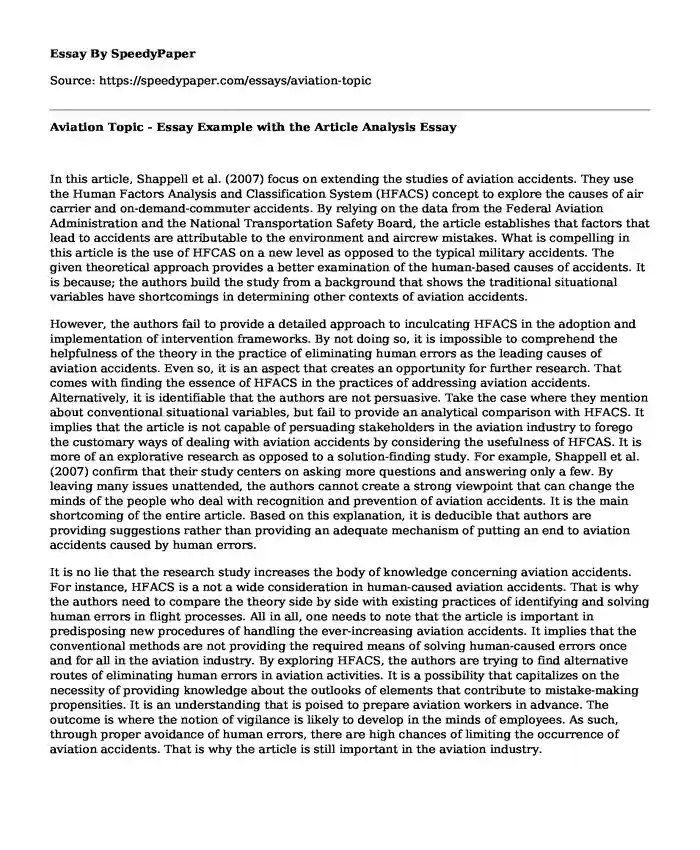
| Type of paper: | Essay |
| Categories: | Aviation Airline industry |
| Pages: | 3 |
| Wordcount: | 611 words |
In this article, Shappell et al. (2007) focus on extending the studies of aviation accidents. They use the Human Factors Analysis and Classification System (HFACS) concept to explore the causes of air carrier and on-demand-commuter accidents. By relying on the data from the Federal Aviation Administration and the National Transportation Safety Board, the article establishes that factors that lead to accidents are attributable to the environment and aircrew mistakes. What is compelling in this article is the use of HFCAS on a new level as opposed to the typical military accidents. The given theoretical approach provides a better examination of the human-based causes of accidents. It is because; the authors build the study from a background that shows the traditional situational variables have shortcomings in determining other contexts of aviation accidents.
However, the authors fail to provide a detailed approach to inculcating HFACS in the adoption and implementation of intervention frameworks. By not doing so, it is impossible to comprehend the helpfulness of the theory in the practice of eliminating human errors as the leading causes of aviation accidents. Even so, it is an aspect that creates an opportunity for further research. That comes with finding the essence of HFACS in the practices of addressing aviation accidents. Alternatively, it is identifiable that the authors are not persuasive. Take the case where they mention about conventional situational variables, but fail to provide an analytical comparison with HFACS. It implies that the article is not capable of persuading stakeholders in the aviation industry to forego the customary ways of dealing with aviation accidents by considering the usefulness of HFCAS. It is more of an explorative research as opposed to a solution-finding study. For example, Shappell et al. (2007) confirm that their study centers on asking more questions and answering only a few. By leaving many issues unattended, the authors cannot create a strong viewpoint that can change the minds of the people who deal with recognition and prevention of aviation accidents. It is the main shortcoming of the entire article. Based on this explanation, it is deducible that authors are providing suggestions rather than providing an adequate mechanism of putting an end to aviation accidents caused by human errors.
It is no lie that the research study increases the body of knowledge concerning aviation accidents. For instance, HFACS is a not a wide consideration in human-caused aviation accidents. That is why the authors need to compare the theory side by side with existing practices of identifying and solving human errors in flight processes. All in all, one needs to note that the article is important in predisposing new procedures of handling the ever-increasing aviation accidents. It implies that the conventional methods are not providing the required means of solving human-caused errors once and for all in the aviation industry. By exploring HFACS, the authors are trying to find alternative routes of eliminating human errors in aviation activities. It is a possibility that capitalizes on the necessity of providing knowledge about the outlooks of elements that contribute to mistake-making propensities. It is an understanding that is poised to prepare aviation workers in advance. The outcome is where the notion of vigilance is likely to develop in the minds of employees. As such, through proper avoidance of human errors, there are high chances of limiting the occurrence of aviation accidents. That is why the article is still important in the aviation industry.
Reference
Shappell, S., Detwiler, C., Holcomb, K., Hackworth, C., Boquet, A., & Wiegmann, D. A. (2007). Human error and commercial aviation accidents: an analysis using the human factors analysis and classification system. Human Factors: The Journal of the Human Factors and Ergonomics Society, 49(2), 227-242.
Cite this page
Aviation Topic - Essay Example with the Article Analysis. (2019, Aug 30). Retrieved from https://speedypaper.net/essays/aviation-topic
Request Removal
If you are the original author of this essay and no longer wish to have it published on the SpeedyPaper website, please click below to request its removal:
- Essay Sample on Continuous Professional Development
- Free Essay: Non-Conventional Practices in Healthcare
- Essay Example about Acid Precipitation (Acid Rain)
- Free Paper Comprising the Responses to the Articles about the Affordable Care Act
- Essay Sample on Critical Analysis and Evaluation of Text
- The Rise and Fall of Adolf Hitler, Free Essay for Everyone
- Paper Example on How Do the Films Disrupt the Male Gaze?
Popular categories




